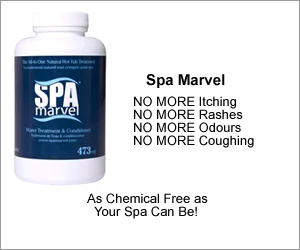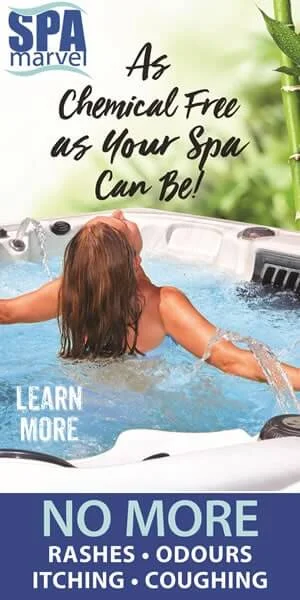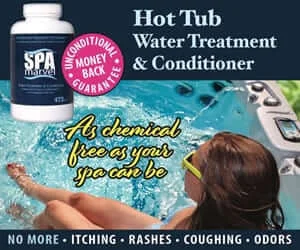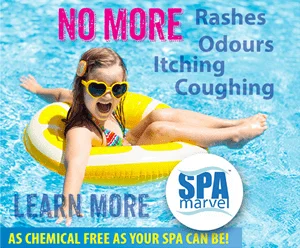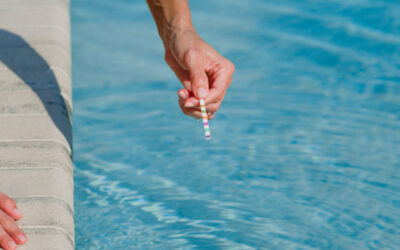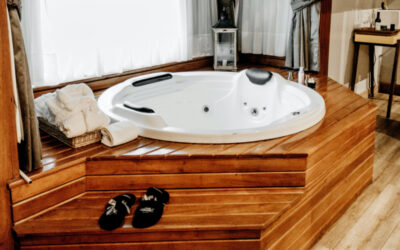Hot Tub Maintenance:
Your Comprehensive Guide on How to Maintain a Hot Tub
Proper hot tub maintenance is essential to the life of your spa and equipment, water clarity, and the health of everyone who enters it. So knowing how to maintain a hot tub and adhering to a strict spa maintenance schedule is crucial. This, and proper hot tub water maintenance, in particular, will dramatically reduce your risk of contracting hot tub rash and other bacterial and chemically caused health conditions.
This comprehensive guide to spa maintenance covers a broad range of topics on how to maintain a hot tub. Read it in its entirety, if you have time. Or use this handy index and skip to the sections you want:
Spa maintenance schedule
How to clean a hot tub
Hot tub water maintenance
Steps to hot tub water maintenance
Other factors in balancing hot tub water
Additional hot tub care tips
Common household products to clean a hot tub
Hot tubs are often referred to as jacuzzis, hydromassage units, tubs, spas, and whirlpools. These terms are used interchangeably in this guide about hot tubs.
SPA MAINTENANCE SCHEDULE
A regular jacuzzi maintenance schedule is essential to maintaining a hot tub and its equipment and safeguarding your health. The following daily, weekly, monthly, and quarterly schedule for how to maintain a hot tub will help prevent murky hot tub water and keep it sanitary.
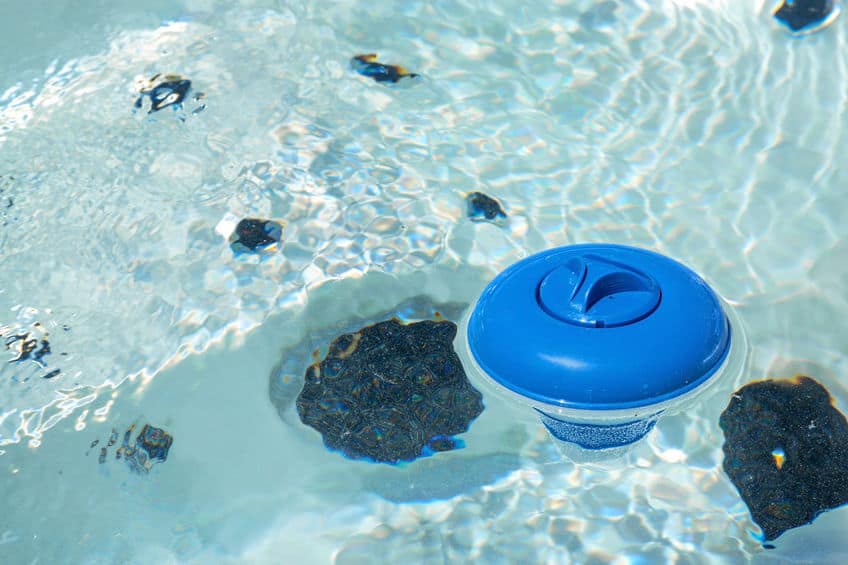
Daily hot tub care
- Add a registered sanitizer after use to maintain the sanitizer levels
- Check and maintain sanitizer levels even when the spa doesn’t get used
- Check the water temperature to ensure there are no problems with the system
Weekly hot tub maintenance
- Test sanitizer, alkalinity, and pH levels
- Shock the water
- Add stain and scale control
- Adjust water pH and alkalinity, if necessary and as required
- Wipe off debris above the water line to reduce contaminants
- Rinse the filters, if needed
- Wipe down both sides of the spa cover to prevent mildew and mold
Monthly spa maintenance
- Clean the filters properly
- Check that jets are correctly working
Quarterly jacuzzi maintenance
- Clean the pipes
- Empty and clean the hot tub
- Remove and install a new or clean filter
- Refill water
- Add chemicals and test levels
- Clean hot tub exterior walls
HOW TO CLEAN A HOT TUB
An essential part of hot tub maintenance is regularly changing the water. Jacuzzi maintenance begins even before you fill the spa. Even the plumbing in a brand new spa should also be cleaned to remove lubricants, wax, sawdust, and other residues from the manufacturing process. So learn the nitty-gritty of how to clean a hot tub correctly and religiously adhere to this in your spa maintenance schedule.
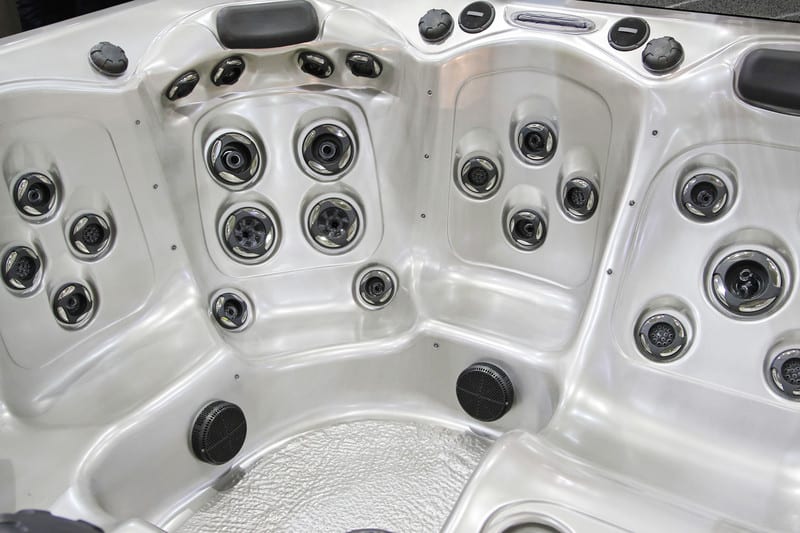
When and how to drain & clean a hot tub
Whether you use your hot tub daily or only once in a blue moon, it needs to be regularly drained and cleaned. This is essential to avoid murky hot tub water and keep it healthy for bathers. Every 3 to 4 months is the standard recommendation for this aspect of jacuzzi maintenance. But the bather load of your hot tub is a more accurate way to determine the necessary frequency. The following calculation will reduce the risk of hot tub water that’s cloudy and smelly:
- Divide the number of Gallons your hot tub holds by 3 (Gallons ÷ 3 = Result)
- Divide the Result by the number of Bathers in your hot tub each day (Result ÷ Bathers = Days)
- Days is the number of Days you can go between changing your water
Depending on how much your hot tub gets used, you may need to empty it every 30-40 days. If your spa gets very little use, the result may be more than 120 days. But for maintaining a hot tub, it’s best to change the water at least every four months since other factors also contribute to jacuzzi maintenance requirements. Also, if you notice any of the following, it’s probably time to drain it:
- algae
- scaling
- cloudy or tinted water
- you have to add chemicals more than usual
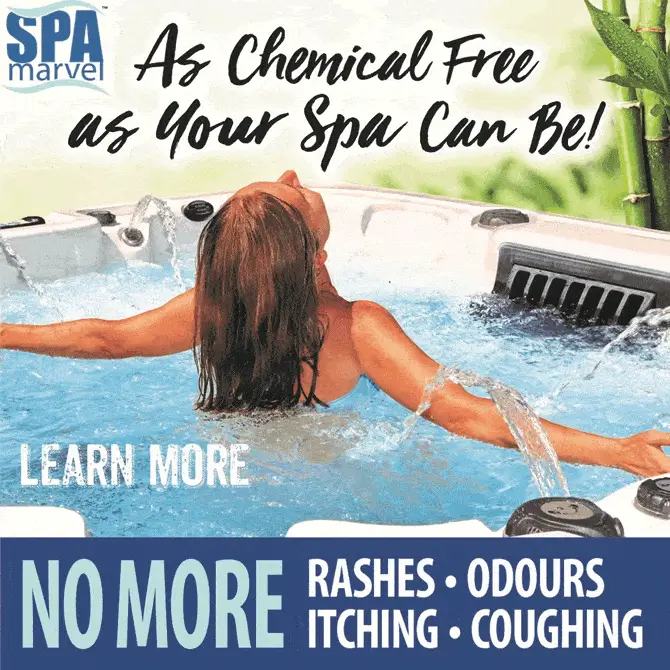
How to clean a hot tub step-by-step
- Hot tub lines can accumulate buildup and eventually cause hot tub water to be cloudy and smelly. The buildup can also result in reduced jet pressure. So before draining the spa, use a line flush, or plumbing cleaner to clean the spa’s plumbing. Instructions for line flushes vary, so follow the product’s instructions. An effective choice for this aspect of hot tub maintenance is Spa Marvel Cleanser. It removes the buildup caused by calcium, lime, body oils, chemical residues, and other contaminants.
- In the rare event the hot tub is infected with pseudomonas, the bacteria that causes hot tub folliculitis, you’ll want to address this before emptying the tub. To kill pseudomonas, add chlorine or bromine to the spa water at the ratio of 2.5 ounces per 100 gallons of water. Be sure to leave the filters and headrests in place so you kill any pseudomonas that may be present on those surfaces. Then ensure the entire plumbing system is exposed to the chlorinated or brominated water for one hour.
- Next, turn off power to the hot tub at the breaker. This will prevent the risk of the pump kicking on while the tub is empty, which could damage the motor.
- Drain the water according to your hot tub manufacturer’s instructions. For easy hot tub maintenance and to speed up the process of emptying your hot tub, get Pump Marvel by Spa Marvel. The average time for Pump Marvel to drain a hot tub is 40 minutes and doesn’t use electricity.
- Knowing how to clean a hot tub surface properly is essential. To prevent damage and preserve the life of your hot tub, use a spa-shell cleaner available at your professional spa retailer, and carefully follow the instructions.
- Cleaning the filters is the last and equally important step in how to clean a hot tub. First, remove the filters and spray them with a garden hose nozzle set to high pressure. Pay special attention to remove debris from the pleats. Then use a product specifically designed to clean spa filter cartridges to loosen and remove the deep-seated debris from the filter fabric available from your professional spa retailer. Spa Marvel Filter Cleaner effectively removes hair, dirt, oil, and grime without the harshness of acids and bleach.
- Wipe down the interior of the filter cabinet with the vinegar and water solution or the spa-shell cleaner you used for the tub. Then reinstall the filters.
Fill the hot tub with fresh water
When you fill the spa, the purer the water, the better to reduce the work involved in maintaining a hot tub. Minerals and other contaminants that naturally occur in water can consume chemical resources necessary for balancing hot tub water chemicals, like sanitizer. It can also cause water quality issues resulting in murky hot tub water. For example, iron in the water can slowly oxidize and cause green and yellow tinges associated with murky hot tub water.
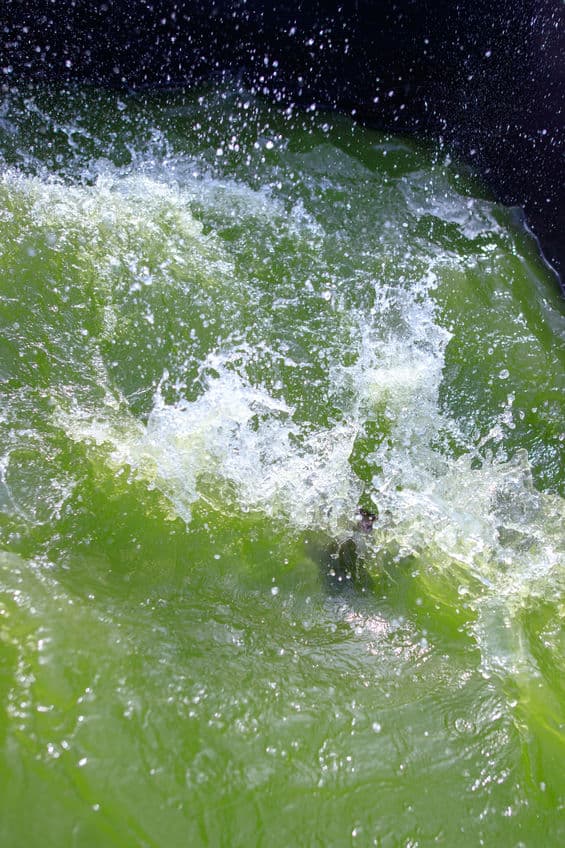
So if possible, fill the spa with soft water for easy hot tub maintenance. Another option is to use a hose prefilter such as the Spa Marvel X10 Water Filter. This reduces water contaminants before the spa gets filled.
Add chemicals to the spa
The next spa maintenance step is to add chemicals to balance alkalinity, pH, and hardness as well as to sanitize your water. Do this as directed by your professional spa retailer. But also read the following on maintaining hot tub water chemistry.
HOT TUB WATER MAINTENANCE
Hot tub water that’s cloudy and smelly is one of the biggest challenges hot tub owners contend with. The following sections on hot tub water maintenance will prevent murky hot tub water and keep it healthy for bathers.
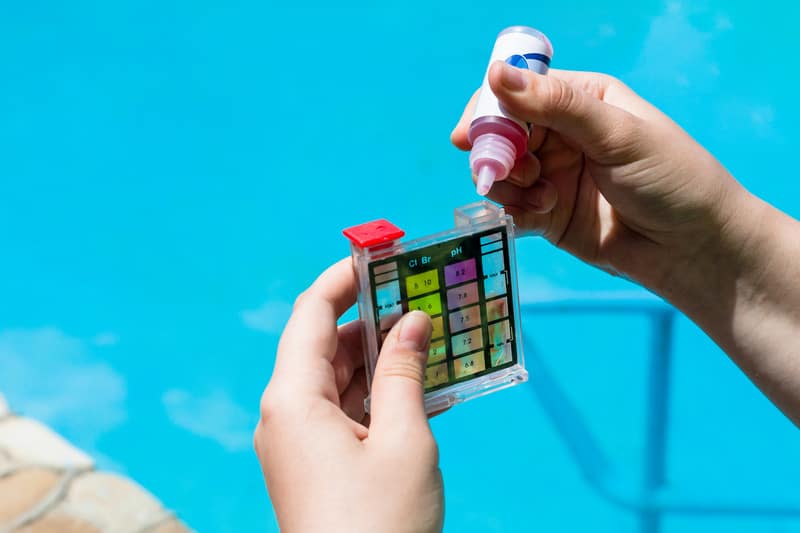
Balancing hot tub water
Because hot tubs don’t get drained after each use, they require chemicals to sanitize them and keep the water clean and clear. But the chemicals can also cause rashes such as bromine and chlorine rash. So balancing hot tub water to proper levels is essential.
Water pH
The ultimate goal is a balanced pH, meaning neither the alkalinity nor acidity of the water is too high or too low. If the water is too alkaline, then the pH is too high, and if it is too acidic, the pH is low. The proper pH range for spa water is typically between 7.2 and 7.8. If the pH is too high or too low, use products designed for raising or lowering pH to adjust it.
Total alkalinity (TA) refers to the measurement of alkaline substances dissolved in the water. When your hot tub water is in balance, the sanitizer will be more effective. Total alkalinity should be between 80 to 120 parts per million (ppm). If the TA is too high or too low, use a product designed to increase or decrease the TA to bring it into the proper range.
For easy hot tub maintenance, use Spa Marvel Water Treatment and Conditioner. It helps keep pH and alkalinity in balance, thereby reducing the frequency of adding chemicals.
Water hardness
Water hardness is another hot tub care factor. When hardness levels are too low (the water is too soft), the water can become corrosive and degrade components of the spa, cause foaming and feel sticky. Typically, a hardness between 175 and 250 ppm is best. You can test hardness levels with a test kit or test strips. If you need to increase hardness, it’s relatively simple compared to some aspects of hot tub water maintenance; just add calcium hardness increaser, available from your professional spa retailer.
Typically, hardness up to 400 ppm is safe for hot tubs, but check with your hot tub manufacturer’s recommendations to be safe. High calcium levels can cause murky hot tub water and scale on the surfaces of your spa. High calcium is more challenging to remedy and may require special filters, scale prevention, or water-clarifying agents.
Sanitizer
Sanitizing is also crucial to maintain a hot tub that’s healthy. Traditional bromine and chlorine programs are the most popular options. Either of these chemicals can cause skin rash and other irritations, and chlorine is very hard on hot tub equipment. But sanitizer is necessary to reduce the risk of hot tub folliculitis and other bacterial infections. Lithium for hot tubs is also a popular choice, but it’s difficult to get because of the enormous amounts required for electric car batteries.
Hydrogen peroxide for hot tubs is another sanitizer option. If you’re thinking of using hydrogen peroxide, consider biguanide products that are hydrogen peroxide-based. Biguanides are the only stand-alone alternatives to traditional sanitizers and contain algaecides and hydrogen peroxide providing periodic oxidation. Baquaspa, Baquacuil, and Softspa are some of your choices.
Weekly shock treatment is recommended with bromine, chlorine, or non-chlorine shock. However, if the water is cloudy or the bather load is heavy, shock treatment may need to be done more often.
The problem is that suspended particulate matter, such as dirt, silt, organic matter, algae, metals and minerals, bacteria and protozoa, and lotions and oils can cause the water to be cloudy. When the particulate matter in the water is so fine that it passes through the filter media, it stays suspended in the water. This causes cloudiness and increases the need for hot tub water maintenance. Spa Marvel Water Treatment & Conditioner can help to sequester the particulate, so it becomes entrapped by the filter media, ultimately improving water quality.
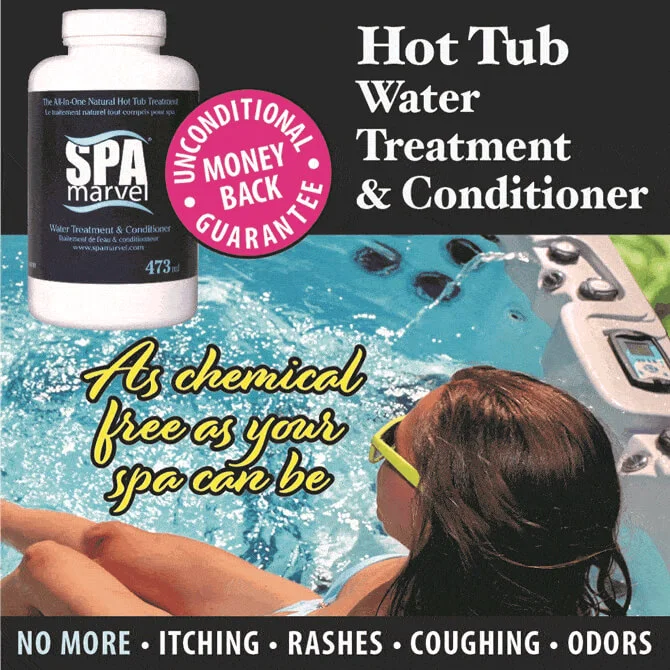
STEPS TO HOT TUB WATER MAINTENANCE
There are several steps to balancing hot tub water to correct pH, total alkalinity, calcium hardness, and sanitizer levels.
Water Treatment and Conditioner
- After cleaning the filters and refilling the spa, heat it to your desired temperature.
- For easier hot tub maintenance and more enjoyable spa experience, add a water treatment, such as Spa Marvel Water Treatment & Conditioner (one bottle for up to 500 gallons of water).
pH, Total Alkalinity and Hardness
- Test the total alkalinity of the water and adjust it accordingly.
- Test the pH and adjust it if required.
- Retest both to make sure they’re in proper ranges.
Water hardness
- Measure the water’s hardness.
- If it’s too low, add hardness increaser; if too high, drain 6 to 12 inches of water and replace it with fresh water.
- Wait for 2 to 3 days, then retest the water hardness.
Protect from Water Impurities
To protect your hot tub from the mineral and metal impurities that naturally occur in water, use a stain and scale control product. Just look for one that’s formulated for hot tubs and follow the product’s instructions. However, unlike other water care products, if you use Spa Marvel Water Treatment and Conditioner, a stain and scale control product isn’t necessary.
Sanitize with Bromine or Chlorine
- Measure the level of bromine or chlorine in your water.
- Add chlorine or bromine according to the manufacturer’s instructions.
- Shock the water once a week.
Shock the water
- Completely remove the hot tub cover.
- Adjust pH and total alkalinity if necessary and as required.
- To prepare for shocking the water, turn on the hot tub for proper distribution of the shock; but turn off any air jets or aerators so the chemicals can do their job effectively.
- Add the appropriate amount of shock.
- Leave the lid open for 20 minutes after shocking.
- Do not use the spa until the sanitizer levels have dropped down to their recommended ranges. In most cases, the recommended chlorine and bromine levels are 3-5 ppm. Once the sanitizer readings are in range, check to ensure that the pH and total alkalinity readings are acceptable, adjust if necessary.
Non-traditional hot tub water mechanisms
There are several non-traditional spa water treatment mechanisms on the market to reduce the use of unhealthy, traditional hot tub chemicals, which are also hard on equipment. These non-traditional spa maintenance systems include ultraviolet light systems, ionizers, ozonators, and enzymes. Such jacuzzi maintenance systems can dramatically reduce the amount and frequency of adding harsh sanitizers and other chemicals. So they’re great for easy hot tub maintenance.
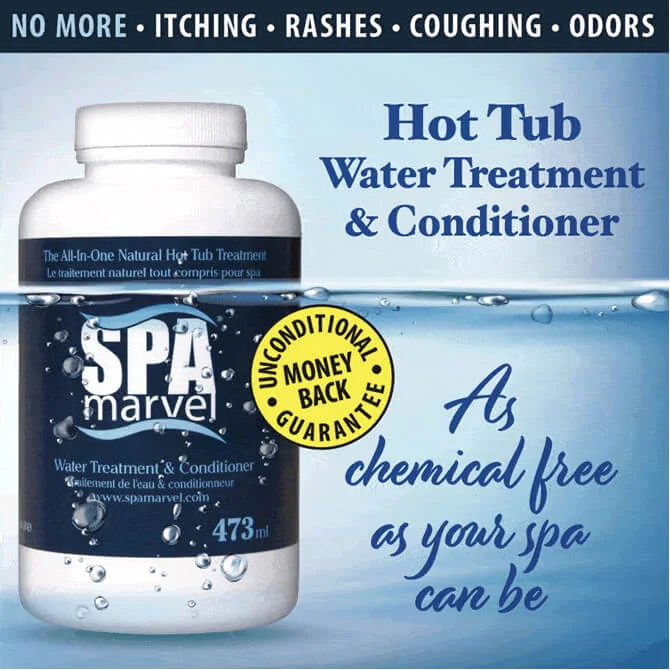
OTHER FACTORS IN BALANCING HOT TUB WATER
Several other considerations will also help ensure easy hot tub maintenance.
Keep the power on to avoid murky hot tub water
Filtration is necessary to prevent hot tub water that’s cloudy and smelly. Ensure that your spa is programmed to filter water sufficiently. Plenty of filtration is pivotal to maintain spa water, so if you’re out of town for an extended period, don’t turn the power off to your spa.
Keep it covered for easy hot tub maintenance
The hot tub heater has to work a lot harder to maintain the water temperature when it isn’t covered. It also results in more water evaporation and requires more chemicals for balancing hot tub water. So use a properly fitted cover when the spa isn’t in use to reduce spa maintenance. At the same time, avoid covering the hot tub too tightly with plastic or other material. Otherwise, you’ll end up with moisture that can damage the hot tub’s trim. Moisture under pressure can also cause electronic problems.
Filter care: a hot tub maintenance essential
Cleaning the filter is also an essential part of hot tub care to avoid murky hot tub water and maintain clarity. Filters should be cleaned at least every month but may need to be cleaned more often; the frequency of filter cleaning is a function of use. When a bather enters the water with body lotion or hair gel or other body-care products, they can muck up the filter and render it useless. Even if the filter got cleaned only a few days ago, these products could cause murky hot tub water. So maintaining clean filters is a necessary part of hot tub care to keep water clarity in check. Find instructions on how to clean a hot tub filter above under the section ‘how to clean a hot tub step-by-step.’ It’s easier to keep a filter clean than it is to clean a filter.
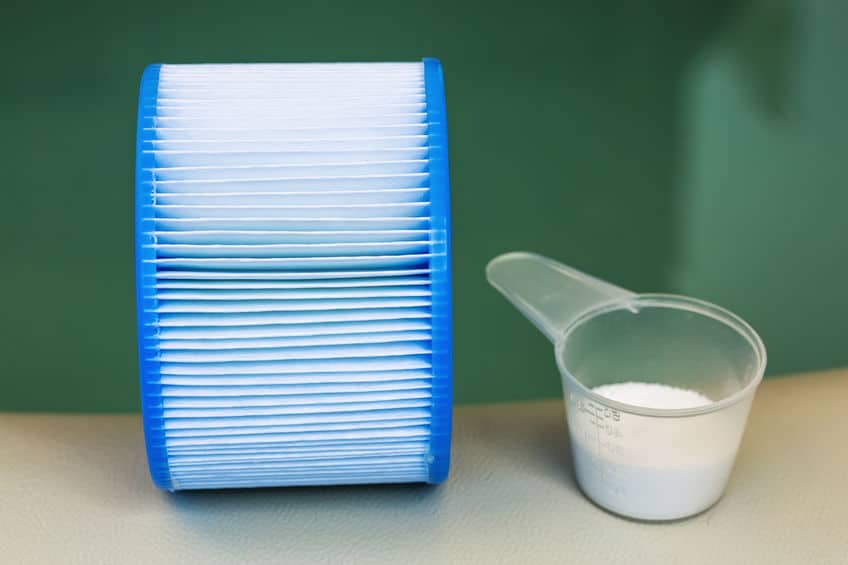
Everything that goes into hot tub water must come out in one way or another. To get an idea of the effect of bathers on hot tub water and the filter, four people in a jacuzzi is equivalent to the bather load of 200 people in a swimming pool. If bathers don’t shower before entering the spa, they’re more or less taking a bath in your hot tub water. They’re introducing all kinds of contaminants that can be on the bather’s body, including makeup, deodorant, hair spray, hair gel, perfume, cologne, as well as residual human waste. To reduce the frequency of filter cleaning and jacuzzi maintenance, ask bathers to shower with soap and water before they enter the hot tub.
ADDITIONAL HOT TUB CARE TIPS
One of the primary purposes of hot tub care is for the health of bathers, and so you can get the most enjoyment from your hot tub. But as previously mentioned, hot tub maintenance is also necessary for the life of your hot tub. So make the following tips part of your hot tub maintenance routine.
Maintaining a hot tub water level
Too much or too little water can damage your hot tub. If there isn’t enough water in your spa, air can get sucked into the pump and destroy it. So hot tub care includes adding water whenever the level seems low. Depending on your spa, you may also need to be careful not to overfill it either. This isn’t a problem with most spas, but the components of some can experience water damage.
Make the cover part of hot tub care
Extend the life of your hot tub cover by brushing it off daily. Then clean it thoroughly a couple of times a month to prevent mold and mildew. To clean the cover:
- Remove it from the spa and lay it out on a piece of plastic or a non-abrasive surface.
- Clean it thoroughly with 303 Multi-Surface Cleaner or one recommended by your professional spa retailer.
- Apply a vinyl conditioner or protectant, such as 303 Aerospace Protectant, to keep the vinyl supple and prevent cracking.
Use only spa chemicals for hot tub maintenance
Hot tub chemicals are designed specifically for spas and jacuzzis and formulated for hot tub surfaces and hot water. Pool chemicals can damage your hot tub. So only use chemicals labeled for hot tub use as recommended by your professional spa retailer.
COMMON HOUSEHOLD PRODUCTS TO CLEAN A HOT TUB
We recommend using only products explicitly labeled for cleaning hot tubs. However, some spa owners prefer using common household products to clean a hot tub. The following are some commonly used household products that are relatively safe to use on your hot tub.
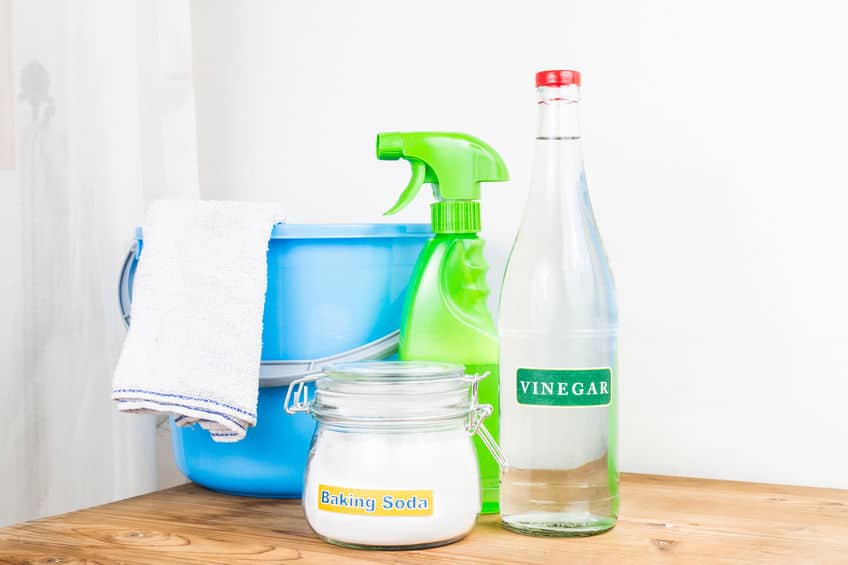
Vinegar and water
This is a practical solution for cleaning the shell of your hot tub. To create the vinegar solution, mix one-part water to one part vinegar in a spray bottle. Spray down the surface of the tub and allow it to sit for fifteen minutes, then rinse it thoroughly.
Next, clean problem areas on your tub’s surface, such as white water lines or stuck-on organic material. Repeat applications of the vinegar solution will usually do the trick.
The vinegar and water solution is also a safe option for cleaning the underside of your spa cover.
Olive oil for gunk
If there’s anything goopy on the shell of your spa, olive oil is one of the common household products to clean a hot tub. Just pour a little olive oil onto a rag and gently rub it until the goop breaks down. Be sure to wash off the oil with mild soap and water when you finish, so the oil doesn’t get in your hot tub water and wreak havoc on your filter.
Diluted bleach
A bleach solution can also be used to clean the shell of your spa, and also helps to sanitize it. Diluted bleach tends to be more effective than the vinegar solution for getting rid of scum lines and tough stains.
To use this method, wear rubber gloves and mix bleach with ten parts of water. To avoid a hazardous chemical reaction, don’t mix bleach with anything else. Then carefully wipe down the shell and rinse it thoroughly.
Diluted bleach is another choice for cleaning the underside of your spa cover, as well. But it’s harsher on vinyl than vinegar and water, and over time can cause the vinyl to break down. Carefully wipe down the underside of the cover with the diluted bleach solution. If mildew is still present, allow it to sit for only a few minutes. Then rinse the cover thoroughly.
Baking soda
Baking soda is another one of the common household products to clean a hot tub. Because it’s a gentle abrasive, it’s a practical solution for scum lines and stains. Create a paste by adding baking soda to a damp cloth. Gently rub until the scum is removed, then rinse off the baking soda with water.



